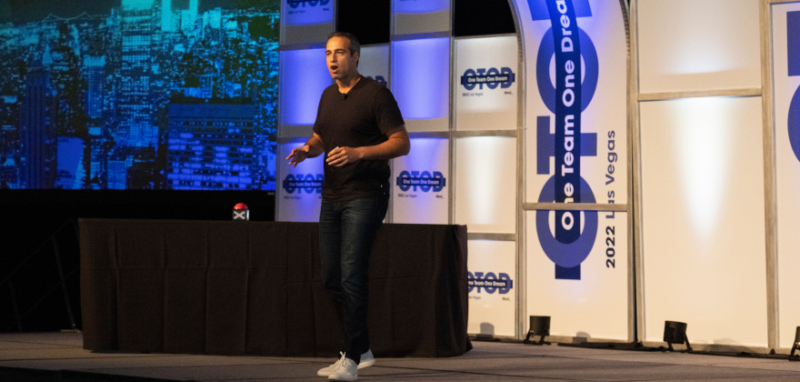
Hired CEO Shares Winter 2024 Tech Hiring Trends: Road to Recovery
The tech hiring industry is still on the road to recovery. As it continues to evolve, we’re here to give recruiting and talent acquisition teams a pulse on the latest trends. Backed by data from the Hired platform this quarter, we’re reflecting on hiring through the start of 2024.
Given market challenges over the past two years, there has been a large dip in the number of tech job postings. This can be traced back to changes in VC funding and waves of layoffs, particularly within publicly-traded companies.
The April 5th Jobs Report from the Bureau of Labor Statistics (BLS), however, offers a beacon. In March 2024, the US economy added 303,000 jobs, beating expectations. Tech occupations showed an increase of 203,000 jobs, suggesting the pace of hiring is accelerating.
Likewise, total active tech job postings for March, which includes rollovers and the new 191,000 listings, was the highest since August 2023. While US unemployment tip-toed from 3.9% to 3.8%, the unemployment rate for tech occupations dropped half a percentage point from 3.5% to 3.0%.
Layoffs in tech ticked up last quarter, despite a 24% decrease in the number of companies with layoffs and an 8% decrease in employees laid off from Q3 to Q4 in 2023. Although a tough experience, we hope these shifts create opportunities for teams to connect with previously passive high-quality talent and for tech workers to find opportunities to join growing organizations.
Related: 3-part series for jobseekers beginning with Part of a Layoff? Steps Jobseekers in Tech & Sales Need to Take First.
State of the tech job market based on Hired data
Though challenges dominated the tech industry lately, the state of the market in 2024 shows some promise.
According to Hired’s internal marketplace data, there was a slight uptick in employer and hiring activity, including placements last month. (This echoes the BLS report of March activity.)
The interview acceptance rate is also trending upwards, averaging nearly 65% over the past two months, highlighting continued interest from jobseekers actively seeking relevant opportunities.
Right now, key technical skills are in high demand, new specializations are gaining traction, and AI is heightening the need for engineers with certain skill sets.
Everyone is curious about the impact of AI on software development, in fact, we’re working on a report to debut later this month! In the interim, national labor statistics tell us that 41% of March job postings were for AI-related positions or roles requiring AI skills, up from 10% a month earlier.
Which skills are currently trending higher? When we study Hired marketplace activity QoQ, open positions listing SQL are up 23%, followed by Kubernetes up 13%, and Python up 9%.
While popular languages like Python are all over the Hired marketplace, evidence suggests jobseekers have an advantage when specializing in a less common skill.
According to our new report, candidates with skills in Go and Scala, for example, received 1.27 times, or 27% more interview requests than the marketplace average, while those with skills in Java and Python received 1.07 times more. Other in-demand skills include Ruby on Rails (1.25x), Ruby (1.22x), and Spark (1.21x).
See more on software engineer tech skill trends in our new 2024 report.
Enterprise companies drive demandThe most in-demand roles overall include the essential standard role types: 1) Backend, 2) Full Stack, and 3) Frontend Engineers.
However, DevOps Engineers increased in percent of the total open active positions by 33% QoQ. Data Engineer also went up 28%. The most-requested skills in these roles for Q1 2024 are:
- AWS
- Terraform
- Kubernetes
- Python
These increases are driven partially by the industry’s widespread adoption of these languages and platforms, as well as the rising demand for talent with AI and ML-friendly skills.
Other roles showing notable growth QoQ include Machine Learning Engineers, Site Reliability Engineers, and Product Managers.
Taking a closer look at the surge in open positions for Data and DevOps Engineers, we find that enterprise (ENT) companies are driving the demand. Almost 50% of the open DevOps positions are coming from large ENT companies with 1000+ employees.
Related: go more in-depth in our new Trends in Software Engineer Specializations: 2024 Report
Generally, the majority of open positions are looking for talent with years of experience (YoE) at:
- 4-6 years (28%),
- 0-2 years (27%),
- or 6-10 years (24%)
Recently, however, the biggest jump in percentage is across 10+ YoE (51%) followed by 2-4 (15%). This is likely driven in part by standard role types (Backend, Fullstack, and Frontend). The other driver? Enterprise companies. Data shows 60% of the open 10+ YoE roles are at ENT companies.
Hybrid work is on the riseWhen we surveyed employers last year, 50% said their 2024 hiring plans were for hybrid roles (compared to 22% in-office and 17% remote). Things seem to have gone as planned. Our recent data reveals hybrid open positions are up 29% QoQ to be 63% of total active open positions on the Hired platform.
This is another trend noticeably driven by enterprise businesses – 75% of enterprise company postings are now hybrid. Onsite-only roles have dropped 64% to only 5% of total active open positions. Data tells us ENTs are largely responsible for this.
The “remote only” work model is holding steady at 30% of open active positions. 50% of eSMB postings are fully remote, compared to just 18% of those from ENTs. Jobseekers are increasingly conforming to this trend toward hybrid and in-person work. After a slight bump in the second half of 2023 from 29% to 30%, the percentage of jobseekers open only to fully remote work dropped to 27%.
The percentage of positions “open to remote” continues to decline. It’s down from 64% in the first quarter of 2023 to 45% in the first quarter of 2024. Meanwhile, hybrid has taken the lead as the most common work arrangement in today’s workplace. According to Gallup, five in ten employees are working on a hybrid schedule.
Salaries flatten outAcross tech, we see salaries are relatively flat or falling (1-4%). The exceptions are a few markets:
By work model, remote salaries are flat or declining except in:
Salaries by segment are only up for eSMBs. Mid-market companies are averaging the highest salaries at $166K while ENTs are the lowest at $156K.
As you optimize your hiring strategy for 2024, we hope these insights help you drive forward to attract the best talent to your teams.
Interested in more data on engineering and tech hiring trends? Subscribe to get the latest insights.
Ready to start hiring top talent? Get a customized demo for your organization’s needs. Searching for a new tech or sales role? Learn how the Hired platform works for jobseekers.Related blog posts

Hired CEO Shares Fall 2023 Tech Hiring Trends: Turnabout
Hiring is steadily coming back; reversing course slightly to focus on the fundamentals As tech...

Hired CEO Shares Summer 2023 Hiring Trends: Tech Hiring Thawing
With continued inflationary pressures, return-to-office plans, and rapidly evolving skill sets,...

Hired CEO Reflects on Tech Hiring in 2023, What’s to Come in 2024
2023 introduced new challenges and transformations to the hiring market. Layoffs, hiring freezes,...

Hired CEO Packs up 2022, Looks Ahead to 2023 in Tech & Sales Hiring
See Hired’s 2023 wrap-up here. 2022 brought big changes. The pandemic and ensuing...

10 Books to Add to Your List for Insights in Leadership and Management
Read a Book Day inspires recommendations from Hired partners Whether you prefer to read a...

Hired Earns 12 G2 Awards for Spring 2024 in Job Search Sites, Recruiting Automation, & Diversity Recruiting
We’re thrilled to enter the Spring season with more awards from G2. What makes these accolades so...

